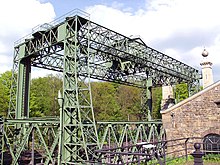MAY 23, 2023 – (Cont.) What made the cradle so dangerous were the hand cranks.
Made of cast iron, they were connected to other cast iron fittings in such a way that by squeezing a mechanism on the crank handle, you could lock the crank in place or release it so you could turn the cradle roller clockwise or counterclockwise and thus raise or lower the boat.
All would go . . . swimmingly . . . unless, Grandpa warned, the crank shaft wasn’t pushed in all the way so that the locking mechanism would “catch.” If you omitted this critical step when the boat was out of the water, thereby creating tension on the ropes, and you let go of the crank, the weight of the boat would cause the heavy-duty cast iron crank to spin out of control. Its outer orbit was large enough to take out both arms and maybe the head of anyone standing close by. At least that was Grandpa’s theory.
To us kids he’d describe the potential horror with sufficient exactitude to scare the living daylights out of us. He also worried that one of us would accidentally bump one of the cranks and unexpectedly release it from its locked position. As a precaution he cut up a heavy-duty inner-tube into wide strips and deployed them as makeshift holders that could be stretched over the crank handles when they weren’t in use. If a gigantic rubber band wouldn’t stop a crank from going berserk and killing one of us, at least the velocity would be slowed so that we’d escape with fractured arms, not die of broken crowns.
As a teenager I grew skeptical of Grandpa’s ostensibly outsized worry about the cradle cranks. By the time Dad allowed me to turn them—after he’d given a full demonstration replete with his penchant for detail—I became even more doubtful that they posed the threat Grandpa claimed. I concluded that if you paid attention to what you were doing, you’d all but eliminate the threat of a cast iron crank whirring around at blurring speed and knocking everyone on the dock to kingdom come. And the giant rubber bands? They were unnecessary, and for the sake of argument, I figured, if you thought they’d slow down a rogue cast iron crank rotating at the speed of light (as Grandpa had warned) . . . who was kidding whom?
One day when a sister and I—just the two of us—were on the dock preparing to launch the Alumacraft, I thought I’d conduct an experiment. In the brashness of youth, I told my sister what I thought of Grandpa’s worry. I then intentionally released the crank from its locked position and let go. Nothing happened. The crank didn’t fly off the handle, or rather, the handle didn’t fly off the crank and destroy our lives or even mess with them a little. The crank didn’t move at all. It just hung there with no hint of criminal intent. I smugly concluded that Grandpa was wrong and I was right.
The summer after Grandpa died, however, a friend of mine was visiting up at the cabin. He was rather fascinated by our antique “boat lift,” and as I demonstrated its ingenious engineering, I told him all about Grandpa’s unfounded fear.
“I show you,” I said. With that I repeated the little experiment I’d conducted a few years earlier for my sister.
All hell broke loose, as the crank unleashed its horrible fury. The cradle roller spun around “at the speed of light” as the bow of the upside down Alumacraft plunged into the water with a mighty splash.
I can’t explain it. Or perhaps I can: maybe Grandpa was there on the dock—in spirit, giving me a good scare to set me straight but making sure no one got clobbered in the process. Or more likely: Grandpa had simply been right all along, and the earlier benign result had been a fluke with a definite but hidden explanation. (Cont.)
Subscribe to this blog and receive notifications of new posts by email.
© 2023 by Eric Nilsson
